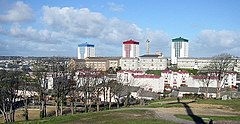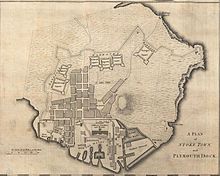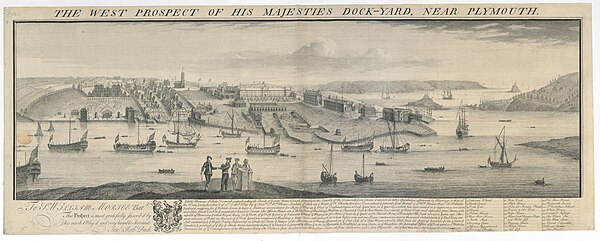Devonport, Plymouth
| Devonport | |
|---|---|
 Devonport skyline | |
Location within Devon | |
| OS grid reference | SX455547 |
| Unitary authority | |
| Ceremonial county | |
| Region | |
| Country | England |
| Sovereign state | United Kingdom |
| Post town | PLYMOUTH |
| Postcode district | PL1 |
| Dialling code | 01752 |
| Police | Devon and Cornwall |
| Fire | Devon and Somerset |
| Ambulance | South Western |
| UK Parliament | |
Devonport (
History
Plymouth Dock
In 1690 the Admiralty gave a contract to Robert Waters from Portsmouth to build a stone dock at Point Froward on the east bank of the Hamoaze at the mouth of the River Tamar. Plymouth Dock, as Devonport was originally called, began around 1700 as a small settlement to house workers employed on the new naval base that was being built around Waters' dock.[4] By 1733 its population had grown to around 3,000,[5] and by 1801 it was already larger than both the nearby towns of Plymouth and Stonehouse together.[6]
Devonport
By 1811 the population of Plymouth Dock was just over 30,000 and the residents resented the fact that its name made it sound like an adjunct of Plymouth. In 1823 a petition to King George IV requested the town should be renamed, and suggested "Devonport". The king agreed to the change of name, which took effect on 1 January 1824.[7][8] To celebrate, the town built Devonport Column next to the recently completed guildhall; both were designed by John Foulston.[2] Devonport was first incorporated as a municipal borough in 1837 under the Municipal Corporations Act 1835.
In July, 1849, the first outbreaks in what became a
Dockyard defences

In the mid-eighteenth century a defensive earthwork was constructed around the town and dockyard. Within these dockyard '
Mount Wise

The high ground south of the town is called Mount Wise. Enclosed within the town ramparts, it was given its own redoubt in the 1770s, with eight guns and two mortars protecting the coastal approach to the dockyard. In earlier times, a
21st-century Devonport
During the millennium decade, Devonport received government New Deal for Communities funding of £48.7 million; this enabled an extensive Regeneration programme to be carried out. Since 2009, the investments have begun to transform Devonport – physically, socially, demographically. Where once the area was run-down, depressed, and classified as 'deprived' in many categories, the 21st-century Devonport is beginning to achieve the city’s vision of … "The recreation of Devonport as a distinct place in modern Plymouth; a vibrant self sustaining community; a place of real quality, variety and interest, the pride of residents, attractive to visitors and a model of 21st Century living, working and playing."[18]
The Admiralty's release of several land plots in Devonport has assisted the Regeneration project. One ex-MoD area, where new homes will be available from 2011, is the Admiralty House site at Mount Wise. Although there are pockets of regeneration work remaining to be completed, the waterfront district of Devonport is becoming one of the desired residential areas of the city of Plymouth.[19]
In 2011, the Devonport Heritage Trail was introduced, complete with over 70 waymarkers outlining the route.[20]
Facilities
Devonport has its own shopping street, a
Devonport is also home to the Devonport Playhouse, a
UTC Plymouth is a university technical college (UTC) which opened in September 2013 near Devonport Park. The UTC is situated on the former site of Parkside Community College,[23] which closed in August 2008 due to falling enrolment.[24]
The Torpoint Ferry service across the Hamoaze (River Tamar) operates from Devonport to Cornwall.
Devonport Naval base/Dockyard has, over the years, been known as "Guz" by

- R. F. Scott (1968-1912, Antarctica) British naval officer and explorer, born Devonport, led the heroic but ill-fated second expedition in 1910 to reach the South Pole. [26]
- N. T. Carrington (1777–1830), schoolmaster and poet.[27]
- Charles Mathews, theatre manager and comic actor, lived here for several months before his death in 1835.
- Leslie Hore-Belisha, 1st Baron Hore-Belisha (1893–1957) was born in Devonport. In the 1945 general election he stood for the seat as a National Independent candidate, but was defeated by Michael Foot. In 1954 he was elevated to the peerage as Baron Hore-Belisha, of Devonport in the County of Devon.
- Ralph Alger Bagnold(1896–1990) was born here. He was a pioneer of desert exploration, and was the founder and first commander of the British Army's Long Range Desert Group. He also made significant contributions to the scientific understanding of desert structures.
- Guy Burgess (1911–1963), one of the Cambridge Five spy ring that betrayed Western secrets to the Soviets before and during the Cold War, was born here.
Charles Darwin spent two months in Devonport from October 1831 waiting for the weather to improve so that HMS Beagle could begin its journey to South America. The ship finally left on 27 December and Darwin later wrote that those two months were "The most miserable which I ever spent".[28]
References
- ISBN 978-1-138-12566-7.
- ^ ISBN 0-14-071050-7.
- ^ "Ward population 2011". Retrieved 15 February 2015.
- ^ Gill (1993), pp. 168–169.
- ^ Gill (1993), p. 173.
- ^ Gill (1993), p. 201 gives the figures as: Plymouth – 16,378; Stonehouse – 3,807; Dock – 23,787
- ^ "Town Hall, Plymouth Dock, 26th Dec. 1823". Royal Cornwall Gazette. Truro. 3 January 1824. p. 3. Retrieved 13 August 2023.
...his Majesty has been graciously pleased to comply with the prayer of the said petition, and to direct that, on and after the 1st day of January next, the town of Plymouth-Dock shall be called and known by the name of Devonport...
- ^ Gill (1993), p. 203.
- ^ Hamilton, Dr. W. (1850). On the Vital Statistics of the Borough of Plymouth, in The London Medical Gazette Vol. XI. London: Longman, Brown, Green and Longmans. p. 614. (online at Google Books)
- ^ Cholera in its Relations to Sanitary Measures, in The British and Foreign Medico-chirurgical Review. London: Samuel Highley. January 1851. p. 23. (online at Google Books)
- ^ "Local Government Board's Provisional Order Confirmation (No. 18) Act 1914" (PDF). legislation.gov.uk. The National Archives. Retrieved 30 December 2023.
- ^ Douet, James (1998). British Barracks 1600-1914. Swindon: English Heritage.
- ^ Historic England. "Scheduled Ancient Monument listing (1021287)". National Heritage List for England. Retrieved 3 March 2015.
- ^ Historic England. "Details from listed building database (1001657)". National Heritage List for England. Retrieved 3 March 2015.
- ^ Historic England. "Grade II listing description (1386244)". National Heritage List for England. Retrieved 3 March 2015.
- ^ "Plymouth Maritime Headquarters (Mount Wise)". Retrieved 21 November 2015.
- ^ "Devonport conservation q" (PDF). City of Plymouth. Archived from the original (PDF) on 26 August 2016. Retrieved 23 August 2016.
- ^ "A framework for Change" (PDF). Plymouth City Council. Archived from the original (PDF) on 15 October 2012. Retrieved 21 November 2015.
- ^ "Devonport Online".
- ^ "Devonport Heritage Trail". Retrieved 29 April 2011.
- ^ "Plymouth Theatre Company :: Devonport : Plymouth :: Plymouth's Independent Theatre Company". www.plymouththeatrecompany.com. Retrieved 27 May 2020.
- ^ Limited, TicketSource. "The Wind in the Willows at The Devonport Playhouse". www.ticketsource.co.uk. Retrieved 27 May 2020.
- ^ "UTC Plymouth | University Technical College Plymouth | Parkside School Plymouth". Archived from the original on 20 April 2013. Retrieved 30 March 2013.
- ^ A joint statement by Plymouth City Council and Parkside Community College Archived 9 June 2011 at the Wayback Machine
- ^ "Pompey, Chats and Guz: the Origins of Naval Town Nicknames". Royal Naval Museum. Archived from the original on 8 August 2011. Retrieved 14 January 2011.
- ^ "Captain Robert Falcon Scott".
- ^ "N. T. Carrington's poems". Copac. Retrieved 13 December 2009.
- ^ "Darwin in Plymouth". Plymouth City Council. Retrieved 29 August 2012.
Sources
- . Encyclopædia Britannica. Vol. VII (9th ed.). 1878. pp. 138–139.
- Gill, Crispin (1993). Plymouth. A New History. Devon Books. ISBN 0-86114-882-7.


